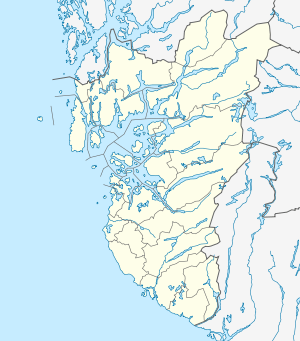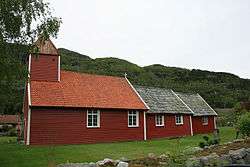Årdal, Rogaland
| Årdal herad | |
|---|---|
| Former Municipality | |
|
View of the Old Årdal Church | |
 Årdal herad Location in Rogaland county | |
| Coordinates: 59°09′10″N 06°09′39″E / 59.15278°N 6.16083°ECoordinates: 59°09′10″N 06°09′39″E / 59.15278°N 6.16083°E | |
| Country | Norway |
| Region | Western Norway |
| County | Rogaland |
| District | Ryfylke |
| Municipality ID | NO-1131 |
| Adm. Center | Årdal |
| Area[1] | |
| • Total | 558 km2 (215 sq mi) |
| Time zone | CET (UTC+01:00) |
| • Summer (DST) | CEST (UTC+02:00) |
| Created from | Hjelmeland in 1859 |
| Merged into | Hjelmeland in 1965 |
Årdal is a former municipality in Rogaland county, Norway. The 558-square-kilometre (215 sq mi) municipality existed from 1859 until 1965. It stretched from the head of the Årdalsfjorden in the west to the county border in the east. It encompassed the southern half of the present-day municipality of Hjelmeland. The administrative centre of the municipality was the village of Årdal where the Old Årdal Church is located.[1]
History
The municipality of Aardal was established in 1859 when the large municipality of Hjelmeland was divided into two: Årdal in the south (population: 1,315) and Hjelmeland og Fister in the north (population: 3,084). On 6 March 1869, a small area of Aardal (population: 40) was transferred to the neighboring municipality of Hjelmeland og Fister. The spelling of the name was changed to Årdal in the early 20th century. On 1 January 1965 the municipality of Årdal was dissolved due to the recommendations of the Schei Committee. The majority of Årdal, with 743 inhabitants, was merged into Hjelmeland municipality once again. At the same time, the Sunngardene district (population: 121) was transferred to Strand municipality.[2]
Church
Årdal is well known for the Old Årdal Church (Årdal gamle kirke) which received its final shape after expansion shortly after it was built in the early 17th century. The church was marked by the work of two local artists, the German painter Gottfried Hendtzschel and the craftsman Lauritz Snekker who was his student. The altarpiece and the pulpit was painted by Hendtzschel. They are made of Snekker who is also responsible for most of the carpentry work. The artistic efforts of Hendtzschel and Snekker within various churches in the vicinity formed a part of the Stranganger Renaissance (Stavangerrenaissance), the cultural period which peaked in the middle of the 17th century in the area around Stavanger.[3][4][5][6]
References
- 1 2 Store norske leksikon. "Årdal – tidligere kommune i Rogaland" (in Norwegian). Retrieved 2016-01-20.
- ↑ Jukvam, Dag (1999). "Historisk oversikt over endringer i kommune- og fylkesinndelingen" (PDF) (in Norwegian). Statistisk sentralbyrå.
- ↑ "Årdal gamle kyrkje" (in Norwegian). Kirkenorge.no.
- ↑ Froysaker, Tine (2003). Church Paintings of Gottfried Hendtzschel in Norway - Part I & II. Goteborg University. ISBN 91-7346-455-4.
- ↑ Gundhus, Grethe (2005). I Guds og Bevaringens navn Fortellingen om tre altertavler og et øksemord. Kulturminner – en ressurs i tiden.
- ↑ Kloster, Robert (1936). Stavangerrenessansen i Rogalands kirker. Stavanger Museum.
